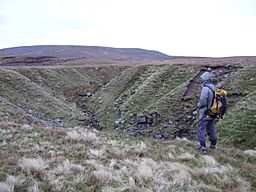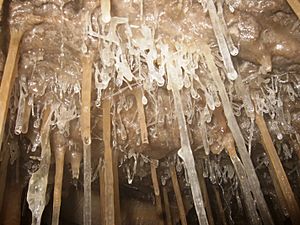Ireby Fell Cavern facts for kids
Quick facts for kids Ireby Fell Cavern |
|
|---|---|

Looking north across entrance sink hole
|
|
| Location | Leck Fell, Lancashire, England |
| OS grid | SD 6737 7734 |
| Depth | 128 metres (420 ft) |
| Length | 4,600 metres (15,100 ft) |
| Discovery | 1949 |
| Geology | Limestone |
| Entrances | 1 |
| Access | Free |
| Cave survey | cavemaps.org |
| BRAC grade | 4 |
Ireby Fell Cavern is a cool cave system in Lancashire, England. It's close to the border with North Yorkshire. This cave is part of a much bigger underground network called the Three Counties System. It connects to other caves like Rift Pot and Notts Pot.
Many people enjoy exploring Ireby Fell Cavern. It begins with several vertical drops, called 'pitches'. After these, you enter huge, dry passages filled with sand. The entrance is a concrete pipe that goes straight down. It's found at the bottom of a shakehole, which is a bowl-shaped dip in the ground. The entrance was last made safe in 2006.
The usual way into the cave is down three pitches named Ding, Dong, and Bell. There's also another way called the Shadow route. This route helps you avoid most of the water when it's raining heavily. After going through long, narrow passages, you reach Well Pitch. This leads you into the main lower sandy areas, known as Duke Street.
At the very end of Duke Street is a spot called Whirlpool Chamber. Here, there's a short underwater tunnel, called a sump. Cave divers used to be the only ones who could get through this sump to reach more passages, known as Ireby II.
In 2007, a clever idea helped non-divers explore Ireby II. People used a simple hand pump and a mud dam to create a temporary pool of water in Duke Street. This allowed them to dig out a passage in the roof of Whirlpool Chamber. This new passage, which was blocked by sand, was dug from both sides. It created a dry way around the sump, so you didn't need to dive through the water. Another dry path around the sump was also dug. It's fittingly called Cripple Creek.
Exploring Ireby Fell Cavern
This cave is very popular with cavers. It offers a mix of challenges, from vertical drops to wide, open passages. The sandy sections are quite unique for a cave in this area.
History of Discovery
The area where Ireby Fell Cavern is located was marked as "The Cavern" on old maps from 1847. However, early explorers couldn't find a good reason for this name. People started digging in the area from 1932 onwards.
In 1949, a small opening on the side of the shakehole was found. This led to a passage that reached the first pitch. Most of the cave was explored and mapped out to the sump at the end of Duke Street. The cave entrance became blocked in 1953, but it was reopened in 1963.
Images for kids



